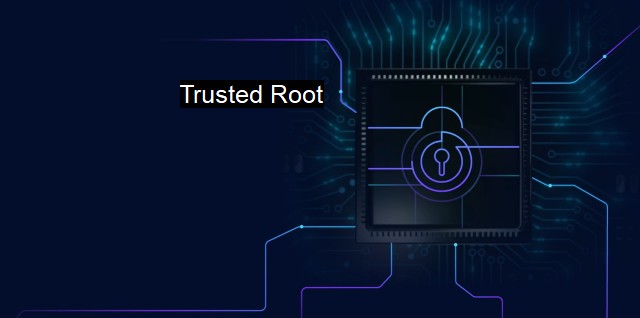What is Trusted Root?
Understanding the Importance of "Trusted Root" in Cybersecurity: The Foundation of Secure Information Exchange
In the realm of cybersecurity and antivirus software, a fundamental concept is the "trusted root." A somewhat technical concept, its understanding is pivotal for all stakeholders in the cyber world – from network administrators, security experts to regular internet users, as its comprehension can significantly aid in strengthening online security.The term "trusted root" is intrinsic to the Public Key Infrastructure (PKI), a framework used to manage identities in a digital environment and security transactions over public networks such as the Internet. the trusted root is the highest level of certification within the PKI hierarchy. It refers to the root certificate authority (CA) that issues digital certificates and essentially "vouches" for all certificates provided by its subsidiaries lower in the certificate authority hierarchy.
A digital certificate is an electronic document that verifies the identity or credentials of a person, system, or website. In a sense, it connects the identity of an entity to a public key, thereby allowing the recipient of the certificate to trust that the public key does indeed belong to the person or entity guaranteed by the Root Certificate Authority. Thus, the primary role of these digital certificates is to ensure that Internet users are interacting with the entity they intend to, preventing any malicious interference or spoofing.
In context, a trusted root CA is one that your browser or operating system implicitly trusts to issue reputable digital certificates. The root certificate is the originating entity in a chain of trust, and its reliability stems from the fact that it signs its own certificate. Since root certificates are the the beginning of trust chains, any server or client software then compares the presented certificate to the trusted root certificates stored within its system.
During this process of cross-referencing known as "Certificate Validation," if the presented certificate matches one of the trusted root certificates in its software's repository, then the certificate is deemed trustworthy. If not, a warning is provided to the user.
It's important to note that trusted root certificates are pre-installed and updated on browsers and operating systems by vendor teams. Reputable tech companies such as Microsoft, Apple, Google and Mozilla go through extensive due diligence before including a root certificate in their trusted stores. For instance, Chrome trusts the certificates that are delivered in the OS trust store of the system on which it's running.
This feature restricts potential vulnerabilities that could arise if users had to manually manage root certificates themselves. The manual management of trusted root certificates could be a tedious and risky exercise even for experts and perhaps unfeasible for an average user with limited technical knowledge.
Despite the stringencies in place to ensure that only legitimate Certificate Authorities can issue certificates, cybercriminals attempt to exploit this trust framework by utilizing rogue certificates issued by compromised authorities or by tricking users into installing false root certificates. Consequently, it becomes part of antivirus software responsibility to detect and remove untrustworthy root certificates that may have seeped into the cyber ecosystem.
a diligent understanding of "trusted root" and the role of trusted root certificates, is key to comprehend the broader picture of internet security. The trusted root acts as the backbone of internet trustworthiness, embracing the authenticity of secure web traffic and transactions, hence playing a pivotal role in ensuring a secure web browsing experience.

Trusted Root FAQs
What is a trusted root?
In cybersecurity and antivirus, a trusted root is a digital certificate that is issued by a trusted third-party root certificate authority (CA) and used to verify the authenticity of other digital certificates.Why are trusted roots important in cybersecurity?
Trusted roots are important in cybersecurity because they establish trust in the authenticity and integrity of digital certificates that are used to secure online transactions and communications. Without trusted roots, it would be difficult to verify the identity of individuals or organizations online, making it easier for cybercriminals to impersonate others and engage in fraudulent activities.How are trusted roots managed and maintained?
Trusted roots are managed and maintained by a network of trusted root CAs, which are responsible for issuing, revoking, and validating digital certificates. These CAs follow strict security protocols and are audited regularly to ensure that they meet industry standards and best practices. Additionally, operating systems and web browsers include pre-installed lists of trusted root CAs that are regularly updated to ensure that users can easily verify the authenticity of digital certificates.What are the risks associated with a compromised trusted root?
A compromised trusted root can lead to the issuance of fraudulent digital certificates, which can be used to conduct attacks such as man-in-the-middle attacks, phishing, and malware distribution. These types of attacks can compromise the security and privacy of online communications, steal sensitive information, and damage the reputation of affected organizations. Therefore, it is important to take measures to protect trusted roots from compromise, such as using strong encryption, implementing access controls, and monitoring for suspicious activity.| | A | | | B | | | C | | | D | | | E | | | F | | | G | | | H | | | I | | | J | | | K | | | L | | | M | |
| | N | | | O | | | P | | | Q | | | R | | | S | | | T | | | U | | | V | | | W | | | X | | | Y | | | Z | |
| | 1 | | | 2 | | | 3 | | | 4 | | | 7 | | | 8 | | |||||||